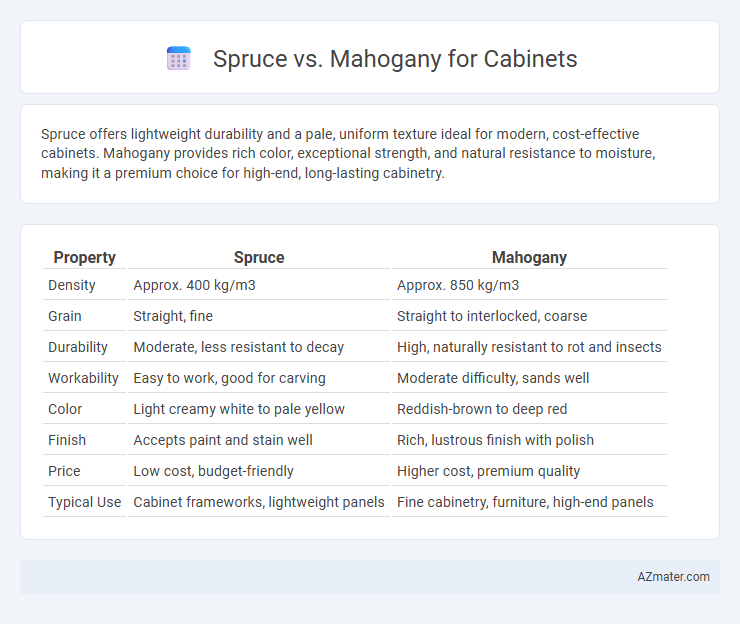Spruce offers lightweight durability and a pale, uniform texture ideal for modern, cost-effective cabinets. Mahogany provides rich color, exceptional strength, and natural resistance to moisture, making it a premium choice for high-end, long-lasting cabinetry.
Table of Comparison
| Property | Spruce | Mahogany |
|---|---|---|
| Density | Approx. 400 kg/m3 | Approx. 850 kg/m3 |
| Grain | Straight, fine | Straight to interlocked, coarse |
| Durability | Moderate, less resistant to decay | High, naturally resistant to rot and insects |
| Workability | Easy to work, good for carving | Moderate difficulty, sands well |
| Color | Light creamy white to pale yellow | Reddish-brown to deep red |
| Finish | Accepts paint and stain well | Rich, lustrous finish with polish |
| Price | Low cost, budget-friendly | Higher cost, premium quality |
| Typical Use | Cabinet frameworks, lightweight panels | Fine cabinetry, furniture, high-end panels |
Introduction to Spruce and Mahogany Cabinets
Spruce cabinets offer a lightweight, cost-effective option with a fine, straight grain that is easy to stain or paint, providing versatility in design and a bright, clean look. Mahogany cabinets are prized for their rich, reddish-brown color, durability, and resistance to warping, making them an ideal choice for high-end, long-lasting cabinetry with a classic, elegant appearance. Both woods provide unique aesthetic and functional benefits, with spruce favoring affordability and ease of customization, while mahogany emphasizes luxury and structural strength.
Wood Grain and Aesthetic Differences
Spruce wood displays a light color with a straight, fine grain that lends a clean and subtle aesthetic to cabinets, making it ideal for minimalist or Scandinavian-inspired designs. Mahogany features a rich, reddish-brown hue with a pronounced, interlocking grain pattern that creates a luxurious and warm appearance, often preferred in traditional and classic cabinet styles. The contrasting grain textures and color depths of spruce and mahogany offer distinct visual impacts, influencing the cabinetry's overall style and room ambiance.
Durability and Lifespan Comparison
Mahogany cabinets offer superior durability with natural resistance to decay, insects, and warping, ensuring an average lifespan of 50 to 100 years when properly maintained. Spruce, being a softer wood, is more prone to dents and scratches, with a typical lifespan of around 20 to 30 years, primarily suited for indoor cabinetry with less wear. For long-term investment and robust performance, mahogany stands out as the preferred choice for cabinetry requiring exceptional strength and longevity.
Weight and Workability in Cabinetry
Spruce is significantly lighter than mahogany, making it easier to handle and transport during cabinetry projects. Mahogany offers superior workability due to its consistent grain and smooth texture, which allows for detailed carving and fine finishing. While spruce may require more care with fasteners due to its softer nature, mahogany provides durability that supports long-lasting cabinetry.
Cost Analysis: Spruce vs Mahogany
Spruce cabinets typically cost between $5 to $8 per board foot, making them a budget-friendly option for cabinetry projects compared to mahogany, which ranges from $20 to $35 per board foot due to its premium quality and durability. The lifespan and maintenance costs of mahogany often offset its higher initial price by offering superior resistance to warping, decay, and insect damage, potentially reducing long-term repair expenses. In summary, spruce provides a cost-effective solution for budget-conscious projects, while mahogany delivers value through longevity and rich aesthetics despite its higher upfront investment.
Acoustic and Insulation Properties
Spruce offers excellent acoustic properties due to its lightweight, low density, and consistent grain, making it ideal for sound resonance and insulation in cabinets. Mahogany, with its denser, tighter grain structure, provides superior thermal insulation and dampens sound vibrations more effectively, enhancing acoustic isolation. Choosing between spruce and mahogany depends on the desired balance between sound resonance and insulation efficiency in cabinetry construction.
Sustainability and Sourcing
Spruce cabinets offer a sustainable choice due to their rapid growth rate and widespread availability in managed forests, reducing environmental impact. Mahogany, while prized for its durability and rich color, often faces sourcing challenges because of overharvesting and stricter regulations tied to its slower growth and limited supply. Choosing sustainably certified spruce wood supports eco-friendly practices, whereas responsibly sourced mahogany requires verification through certifications like FSC to ensure ethical harvesting.
Maintenance and Care Requirements
Spruce cabinets require regular sealing and protection from moisture due to their softer wood grain, which is prone to dents and scratches over time. Mahogany offers superior durability with natural resistance to decay and insect damage, reducing the frequency and intensity of maintenance needed. Proper cleaning with mild soap and periodic polishing helps maintain the rich finish of mahogany, while spruce demands more vigilant upkeep to prevent wear.
Best Uses and Application Scenarios
Spruce offers lightweight strength and a pale, uniform grain, making it ideal for cabinet interiors, structural components, and painted finishes where cost-efficiency is prioritized. Mahogany's rich, reddish-brown hue and natural durability suit high-end cabinetry, formal rooms, and applications requiring intricate detailing or a luxurious appearance. For kitchens and furniture exposed to moisture, mahogany provides better resistance, while spruce excels in budget-friendly projects emphasizing ease of machining and a clean, smooth surface.
Choosing the Right Wood for Your Cabinets
Spruce offers a lightweight and cost-effective option for cabinets, known for its pale color and uniform texture that allows for smooth finishes, making it ideal in modern, minimalist designs. Mahogany features a rich, deep reddish-brown hue with natural durability and resistance to warping, providing a luxurious and long-lasting cabinet choice that ages beautifully over time. Selecting between spruce and mahogany depends on budget constraints, desired aesthetic, and the cabinet's functional requirements, with mahogany preferred for high-end, statement pieces and spruce favored for economical, versatile projects.

Infographic: Spruce vs Mahogany for Cabinet
 azmater.com
azmater.com